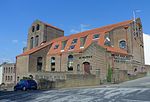Pepper Pot, Brighton
1830 establishments in EnglandCharles Barry buildingsGrade II listed buildings in Brighton and HoveTowers completed in 1830Towers in East Sussex ... and 1 more
Use British English from October 2013

The Pepper Pot, also known as the Pepperpot, the Pepper Box or simply The Tower, is a listed building in the Queen's Park area of the English city of Brighton and Hove. Designed and built in 1830 by architect Charles Barry in the grounds of a villa built for the owner of Queen's Park, it survived the villa's demolition and is now one of its only surviving remnants. Its original purpose is unknown—several possible explanations have been given for its construction—and it has had a wide variety of uses in the 20th century. It is now owned by Brighton and Hove City Council, and is protected as a Grade II listed building.
Excerpt from the Wikipedia article Pepper Pot, Brighton (License: CC BY-SA 3.0, Authors, Images).Pepper Pot, Brighton
Tower Road, Brighton Queen's Park
Geographical coordinates (GPS) Address External links Nearby Places Show on map
Geographical coordinates (GPS)
| Latitude | Longitude |
|---|---|
| N 50.8272 ° | E -0.1247 ° |
Address
Pepper Pot
Tower Road
BN2 0GF Brighton, Queen's Park
England, United Kingdom
Open on Google Maps











